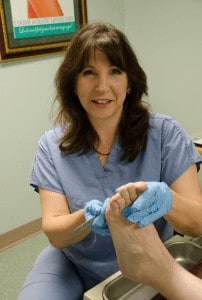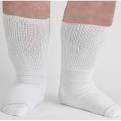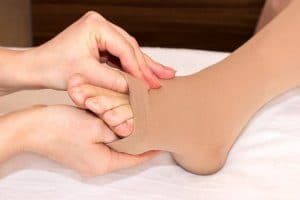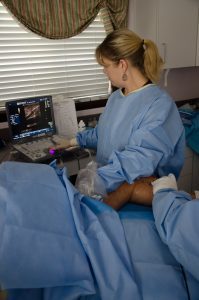Wound Care

All diabetics should have a podiatrist they know and trust. It’s estimated that over 15% of patients with diabetes will eventually develop ulcers on their feet and ankles. Without prompt wound care treatment, these ulcers can progress to the point where amputation is the only option. According to the Centers for Disease Control (CDC), over 185,000 amputations are performed each year in America. About 73,000 of these are toe and foot amputations directly resulting from diabetes.
FOOT ULCERS & DIABETIC WOUND CARE PITTSBURGH

Gentle, Fast Relief with Proper Wound Care
Are you suffering from pressure ulcers, venous ulcers, diabetic ulcers and diabetic foot sores or other open foot wounds or leg wounds? If a painful or infected foot or lower leg wound is bothering you, do not wait any longer to contact the Beaver Valley Foot Clinic. Our caring and experienced experts can help with all of your wound care. From necessary wound dressings to needed pain
Information on Wound Care Treatment:
Our wound care specialist will evaluate each wound and choose the appropriate wound care products and wound care dressings for your own personal wound care management. Under most insurances wound care supplies, depending on the types of wound will be covered and can be sent to your house.
Find Relief with Our Beaver County, Cranberry Twp and Pittsburgh area Foot Specialists
General wound care centers can often be very expensive, causing you to prolong wound care and treatment. But let neither foot pain nor the worry of receiving an expensive medical bill, keep you off of your feet. Similar wound care can be coordinated in our offices for a fraction of the cost. Also keep in mind that our doctors of podiatry, because of the specialty, are often the best-trained physicians to treat your pain and care for your wounds.
Newest Wound Care Technology : Moleculight

At Beaver Valley Foot Clinic’s wound care clinic, we have wound care centers at 4 convenient locations.
Diabetes is a chronic, often progressive illness. While it can’t be cured, proper treatment can minimize its impact on your life. When poorly managed, diabetes can affect nearly all parts of your body, especially your feet. It’s a well-known fact that, as a group, diabetics suffer more foot problems than any other population.
It’s precisely for this reason that all diabetics should see a podiatrist regularly. This will greatly reduce your risks of diabetes-related complication such as bacterial infections, fungal infections, ulcers, and other types of sores. In worst case scenarios amputation of the toes, foot, or even the entire lower leg may become necessary. In America alone about 73,000 amputations occur each year as a direct result of poorly controlled diabetes. The sad fact is that many, if not most, of these amputations could have been prevented with a podiatrist’s care.
Diabetic support shoes get most of the attention, but diabetic socks are perhaps equally important. When worn consistently they offer several key benefits which we’ll discuss below. But first, here’s some basic information on diabetes as it relates to your feet.
While proper foot care and hygiene is important for everyone, this is especially true for diabetics. This mainly comes in the form of specially made diabetic footwear, which includes diabetic socks.
We’re ready to help.
Schedule an appointment with Beaver Valley Foot Clinic today.
The Inflammatory Response: the body’s acute healing state.
The human body has the miraculous ability to heal itself under normal circumstances. Anyone who has watched a cut or scrape mend can observe that healing occurs in multiple stages. Inflammation is an essential (and often misunderstood) part of this extraordinary process.
What is actually occurring at the cellular and tissue level is so complex that we’re just beginning to understand it. We can, however, influence the course of healing through various treatments which fall under the umbrella of Regenerative Medicine. This includes minimally invasive procedures such as Platelet Rich Plasma (PRP) Therapy and Stem Cell Therapy. Many also include Extracorporeal Shockwave Therapy (ESWT) as a Regenerative Therapy.
All of these treatments, and others, directly alter the body’s inflammatory response. One of the first steps of the healing process is a sharp increase in leukocyte activity. “Leukocytes” is simply the technical medical term for white blood cells. These play a key role in what is known as “angiogenesis.” This simply means the growth of new blood vessels (“angio” = blood, “genesis” = creation). This is vital, because only when a viable blood supply has been established can healing begin.
Almost immediately following ESWT for plantar fasciitis evidence of leukocyte mobilization can be seen. This quickly leads to the early stages of angiogenesis. This is always accompanied by some level of swelling, warmth, and possible visible redness. In other words, ESWT and treatments like it purposely create inflammation. This is done in a very controlled fashion with one specific goal—to jump-start the healing process.
Treating venous stasis ulcers of the legs and ankles.
This type of ulcers aren’t just unsightly but can be extremely painful as well. It’s not uncommon for patients to rate their pain at a 7, 8, or even 9 out of 10. Needless to say this has a significant negative impact on their quality of life. Infection is also a possibility and can lead to serious complications. Treatment can be challenging, but the following options have proven themselves effective:
Home based treatments
Compression therapy won’t reverse existing vein disease or ulcers but can prevent them from getting worse. They also provide relief from the physical symptoms which accompany advanced of vein disease.
- Sterile dressings are used to keep ulcers clean and dry to provide a more optimal healing environment.
- Healthy lifestyle changes can go a long way in helping existing ulcers heal and prevent new ones from forming. This includes quitting smoking and maintaining a healthy weight through diet and exercise. Even simple changes like regularly elevating your feet can reduce symptoms.
Office Treatments
Vacuum-assisted closure techniques aid in the healing process by improving circulation. This is also known as negative pressure therapy.
- Hyperbaric oxygen treatment places the leg in an oxygen-rich environment to promote healing. This also helps reduce inflammation and helps manage active infections.
- Antibiotics are used to treat obviously infected ulcers. They’re administered in oral and topical forms.
- Anti-clotting medications are sometimes used in patients who are prone to excessive clotting. This indirectly improves blood flow, improving the healing response.
- Aspirin is a surprisingly potent non-prescription blood thinner and anti-clotting medication. It performs many of the same functions as its prescription counterparts.
- Oral zinc supplements reduce excessive inflammation and swelling in some patients. Zinc supplements are inexpensive and are an easy addition to any ulcer care regimen.
- Debridement is the gentle removal of dead tissue located in and around the ulcer. In many cases, especially with large or deep ulcers, debridement is essential for successful treatment.
Treatments to Reduce Swelling
- Skin grafting is occasionally used in both a therapeutic and reconstructive role. Much as it sounds, healthy skin is harvested from elsewhere on the body and transplanted over an active ulcer.
- Radiofrequency (RF) ablation doesn’t treat ulcers directly. Instead it’s used to treat the diseased veins which are ultimately cause most ulcers. During an RF treatment an ultra-thin wire catheter is inserted into the vein being treated. Radiofrequency energy then heats the inside of the vein which causes it to collapse. Blood is rerouted to healthier veins and the patient’s overall circulation is greatly improved.
- Microphlebectomy refers to the surgical removal of surface varicose veins. Small puncture incisions are made and the veins are then removed with specialized instruments. Much as with RF ablation, this improves overall circulation which enhances the body’s natural healing response.
- Sclerotherapy is less invasive than microphlebectomy yet accomplishes much the same goal. The only drawback is that it’s only effective on varicose veins smaller than 5 mm in diameter.
It’s important to remember that leg ulcers are a serious medical condition which can have long term consequences. If you have existing ulcers take control of the situation and start treatment. If you’re just beginning to develop ulcers then seek treatment immediately. As with many conditions, treatment is likely to be more effective if started as soon as possible.

MyOwn Skin™ is an autologous( meaning your own) skin grafting office procedure using a small donor piece of the patient’s own skin and a few tubes of the patient’s blood from which we grow a large partial thickness skin graft in the lab in about 7 days. This is then transplanted onto a burn or wound and healing starts immediately!
MyOwn Skin™ is a painless, non surgical procedure which leverages a small sample of a patient’s own skin to produce up to three 100cm² skin grafts in a week.
Can I take over-the-counter pain medications for wound pain?
Yes, over-the-counter (OTC) pain medications can be used to help manage wound pain, provided you follow the recommended dosage and guidelines. Common OTC pain relievers such as acetaminophen (e.g., Tylenol) or nonsteroidal anti-inflammatory drugs (NSAIDs) like ibuprofen (e.g., Advil, Motrin) can be effective in reducing mild to moderate pain associated with wounds.
However, it’s important to note that pain medications only provide temporary relief and do not treat the underlying cause of the wound. It’s crucial to properly clean and care for the wound, following appropriate wound care protocols. If the pain persists or worsens despite using OTC pain medications, or if there are signs of infection or other complications, it’s advisable to seek medical attention for further evaluation and guidance.
Additionally, if you have any pre-existing medical conditions or take other medications, it’s essential to consult with a healthcare professional or pharmacist before taking OTC pain medications to ensure they are safe and appropriate for you.
Is it normal for a wound to have some drainage or discharge?
Yes, it is normal for a wound to have some degree of drainage or discharge during the healing process. The type and amount of drainage can vary depending on the stage of healing and the characteristics of the wound. Here are some common types of wound drainage:
- Serous Drainage: This is clear, watery fluid that often occurs during the initial stages of wound healing. It consists of plasma, proteins, and some white blood cells.
- Sanguineous Drainage: This is typically red or bloody drainage, which may occur in the early stages of wound healing or after certain procedures. It is more common in fresh or deeper wounds.
- Serosanguineous Drainage: This is a combination of serous and sanguineous drainage, appearing pink or slightly bloody. It is common in wounds that are healing well.
Benefits of consistently wearing diabetic socks:

· Absorbing moisture. Diabetic socks are specifically designed to wick sweat away from the skin. This is important for diabetics, since excess moisture can exacerbate existing sores. It also increases their chances of becoming infected.
· Compression therapy. Most high-end diabetic socks deliver graduated compression to the lower leg. This simple means that they provide more compression at the ankles and less as they go up. This squeezes blood back up the leg, greatly improving circulation.
· Friction reduction. Diabetic socks are made of very soft fabric which reduces friction between your shoes and your skin. This protects the feet in much the same way as moisture absorption.

Beaver Valley Foot Clinic Offers Proper Wound Care & Foot Care!
- Pressure Ulcers
- Venous Ulcers
- Diabetic Foot Ulcers & Management
- General Open Wound Care (Diabetic and Non-Diabetic)
Realities of Foot Pain, Discomfort and Treatment Avoidance
The reality of your foot discomfort or pain is this: it needs treated properly or else the pain and its problem source will amplify and worsen. Not only that, if you are dealing with a medical issue that your wounds are a result of, such as Diabetes, it is only more imperative that you seek the help of the Beaver Valley Foot Clinic, ASAP.
“The last place I went, they sort of blew me off when what they were doing wasn’t working. I felt like they thought it was my fault.”
”I’ve had fairly severe ulcers on my heels for a good while now. My doctors started telling me that parts of my foot might need to be amputated if things got worse! Needless to say I was scared and looking for options when a friend told me I should talk to Dr. T- she had helped him with some pretty severe ulcers before.
” I got the impresssion right away that she had lots of experience with these sorts of ulcers, and this made me feel a lot better immediately. My confidence wasn’t misplaced- for the first time in 1 1/2 years my feet are getting better.”
We Also Help with Diabetic Ulcers & Wound Care
We even specialize in diabetic wound care. Diabetes is a metabolic disease that effects how the body uses and produces insulin. Effecting millions of people each year, it also ranges in severity depending on the individual. Some diabetes suffers may develop diabetic ulcers, which are open sores that form when pressure prevents blood flow to the skin. Specifically, with diabetes-related wounds, when left untreated by podiatrists and wound care nurses , these pressure wounds (or ulcers) can go from painful, to limb-threatening.
Testimonials
““I have a condition called Venous Insufficiency, which prevents blood from getting to the veins, causing tissue to break down, and leading to ulcers and sores, which, because of the poor circulation, heal so slowly that, at times, I’ve had them last for six months. Dr. Tina has been treating me for these ulcers for awhile; but, many times, while the wounds appeared to be healing on the surface, they didn’t go away completely. But, because she never gives up on searching for newer, better treatments, she’s now using a medication that, besides greatly accelerating the healing process for my wound, has healed it thoroughly.
This has made such a big difference in my life, because I used to have to have my leg – or legs – bandaged all of the time, sometimes for days, so just taking a shower was a big hassle. Even worse, the ulcers would sometimes seep right through my Unna boot (a light, medicated bandage that forms a soft cast) to my clothes, which was very unpleasant, especially when I was out in public.
So, this has improved my life tremendously; but, more than just the process and the medication, it’s Dr. Teimouri herself. A lot of doctors come into the room, get some information, treat you, and that’s it; but with her, it’s like talking to a friend. In fact, it’s almost like your next door neighbor is dropping by to see how you are, but then she treats you, too! She’s immensely caring and compassionate
Trust in Dr. Teimouri; Trust in the Beaver Valley Foot Clinic
Contact the Beaver Valley Foot Clinic now for more information on managing and properly caring for open wounds. You deserve to walk without wound-care pain and discomfort. To schedule an appointment call 878-313-3338 or visit Dr. Teimouri and her experienced staff in person at one of the conveniently located Beaver Valley Foot Clinics. Begin the steps to proper wound care and pain relief. Trust in Dr. Teimouri and the Beaver Valley Foot Clinic to care for all of your foot discomforts!
FAQ:
Q. What is a wound?
Wound care pictures
- A. Wound care definition – is a break or opening of the skin. The epithelium loses its protective functions after injury.
Q. What factors affect wound care healing?
- A. Some of the factors that determine the chances of your wound healing are:
- General nutrition and hydration
- Presence of infection and judicious/ appropriate use of antibiotics
- relief of pressure and friction off the ulcer
- Use of at home wound care, training, wound care supplies, wound care nurses, home visits if necessary
- Wound control of drainage, preventing further breakdown
Breaking Down Biofilm
Have you ever heard of biofilm? No it’s not a biographical movie, it’s an ultrathin, protective layer that entrenched bacterial colonies will sometimes produce. Just like our autoimmune system will defend our bodies from harmful pathogens, bacteria use the biofilm to keep out antibiotics. It creates a physical defensive barrier to protect the colony against antibiotic treatment. Shock wave therapies (like PACE) have been proven to break down the biofilm barrier, allowing antibiotics to penetrate into the bacteria and eradicate the colony.
Inflammation Response
Just as with many biological processes, there are several different pathways and stages of wound healing. One of them, is the inflammatory (or swelling) stage. While there is a misconception out there that swelling is bad and should be avoided, it is in fact a necessary step in the healing process. PACE treatment will trigger an immediate inflammatory response. You might be asking yourself, “how does that help?” Well, swelling signals the body to initiate certain actions to repair any damage in the area.
Medical investigators at highly respected research hospitals have discovered that PACE treatments lead to an increase of white blood cells that pass through the vessel wall, moving into the treated tissues. The leukocytes in white blood cells are central to the healing process. Increasing their flow during the inflammatory phase of wound healing triggers the release of compounds that cause the growth of new blood vessels (pro-angiogenic compounds). Researchers have demonstrated that pro-angiogenic factors have a profound impact on healing. Shock wave treatment causes the wound to move quickly through the inflammatory phase into the proliferation (cell duplication) phase of healing.

 Compression therapy
Compression therapy Vacuum-assisted closure techniques
Vacuum-assisted closure techniques